Table of Contents Show
Introduction
Wood countertops are more than just a functional work surface in your kitchen. They bring warmth, natural beauty, and a touch of elegance to any space. The unique grain patterns and rich colors of wood can elevate the aesthetics of your kitchen design, making it feel cozy and inviting.
DIY projects, such as building your own wood countertops, offer several benefits:
- Cost Savings: Crafting your own countertops can be significantly cheaper than purchasing pre-made ones.
- Customization: You get to choose the type of wood, finish, and design that best matches your style.
- Satisfaction: There’s immense satisfaction in creating something with your own hands.
In this guide, you’ll discover how to build wood countertops like a pro. From selecting the right materials to cutting and joining boards, sanding to perfection, finishing with finesse, and sealing for longevity—this step-by-step tutorial covers it all.
But before we dive into the woodworking process, it’s worth considering how these new countertops will fit into your overall kitchen design. 7 Fabulous Kitchen Remodelling Designs could provide some inspiration on how to integrate your DIY wood countertops into a broader kitchen remodel.
Additionally, while you’re revamping your kitchen with these beautiful DIY wood countertops, you might want to implement some labeling techniques to keep your house organized. This will help maintain cleanliness and order in your newly designed space.
Ready to transform your kitchen with beautifully crafted DIY wood countertops? Let’s dive into the world of woodworking and turn your vision into reality!

1. Understanding Wood Countertops
Definition and Features of Wood Countertops
Wood countertops bring warmth and natural beauty to your kitchen, creating a cozy and inviting atmosphere. These countertops are typically made from hardwoods or softwoods and can be customized to fit any kitchen design. Unlike stone or laminate, wood offers a unique texture and patina that ages gracefully over time.
Comparison Between Butcher Block and Regular Wood Countertops
Butcher block countertops are a popular choice for their durability and aesthetic appeal. They are constructed by gluing together strips of wood with the edges facing up, creating a sturdy and attractive surface ideal for cutting and food preparation.
Regular wood countertops might be crafted from a single piece of wood or several planks joined side by side with the grain running along the length. While not as robust for heavy-duty chopping as butcher blocks, they provide a more seamless appearance.
Advantages of Using Hardwood vs. Softwood
When choosing between hardwoods and softwoods for your countertop, consider the following:
Hardwoods:
- Maple: Known for its fine grain and durability, making it an excellent choice for both regular and butcher block countertops.
- Oak: Offers strength and an attractive grain pattern; perfect for high-traffic kitchens.
- Walnut: Provides a rich, dark color that adds elegance to any kitchen design.
Softwoods:
- Pine: Less durable but more affordable; best suited for decorative purposes rather than heavy use.
- Poplar: Also more budget-friendly but prone to dents and scratches; often used in less demanding applications.
Choosing the right type of wood involves balancing factors like durability, cost, and aesthetic preferences. Each type has its own set of features that make it suitable for different kitchen environments.
Exploring Alternative Materials
While wood countertops have their charm, it’s worth considering other materials that might suit your needs better. For instance, Silestone, known for its durability and low maintenance requirements, could be an excellent alternative. On the other hand, if you’re looking for something modern and prestigious, concrete worktops might be worth exploring as they offer a sleek look while being incredibly durable.
2. Material Selection for Your Countertop
Selecting the right material for your countertop is essential in achieving a balance between durability, cost, and aesthetics. Here’s how to choose the best wood for DIY countertops.
Factors to Consider
When selecting wood, keep these points in mind:
- Durability: Hardwoods like maple, oak, and walnut are more durable and resistant to scratches and dents compared to softwoods like pine and poplar.
- Cost: Budget plays a significant role. Hardwoods tend to be more expensive but offer longevity, while softwoods are more cost-effective but may require more maintenance.
- Aesthetics: The wood’s grain pattern and color should complement your kitchen’s design. For example, walnut offers a rich, dark finish, while maple provides a lighter, cleaner look.
Popular Woods for DIY Kitchen Countertops
Different woods bring unique characteristics to your countertop:
- Maple: Known for its durability and fine grain, making it ideal for butcher blocks. It has a light color that brightens up the kitchen.
- Oak: Offers a prominent grain and is highly durable. Available in red or white varieties; white oak is particularly water-resistant.
- Walnut: Prized for its rich, dark color and smooth texture. It’s also durable but slightly more expensive.
- Pine: A softer wood that’s budget-friendly. Pine has a rustic charm but may wear down faster than hardwoods.
Where to Purchase Materials
You have several options when it comes to purchasing materials:
- Lumber Yards: Often provide higher-quality wood at competitive prices. You can also inspect the wood before buying.
- Online Sources: Websites like Woodcraft or Rockler offer various types of wood. Online shopping is convenient but may come with higher shipping costs.
- Local hardware stores or specialized woodworking shops can also be excellent places to find quality wood for your project.
Additional Considerations
While this guide focuses on wood selection for countertops, it’s equally important to consider other aspects such as the different types of countertops available and their pros and cons before finalizing your purchase. Furthermore, if you’re planning a comprehensive kitchen renovation that includes cabinet building, you might find these DIY kitchen cabinet plans helpful.
Lastly, if you’re aiming for a specific style or theme in your kitchen such as an authentic country kitchen, or seeking kitchen organization secrets for a happier lifestyle, there are plenty of resources available to assist you in achieving your dream kitchen with some budget-friendly kitchen makeover ideas.
3. Planning Your Project
Accurate measurement is the foundation of any successful DIY project, especially when it comes to creating custom wood countertops. Here’s how you can ensure your measurements are spot-on:
1) Measure Your Kitchen Space
Start by measuring the length and width of the area where you plan to install the countertop. Use a tape measure to get accurate dimensions, including any corners or curves. Make sure to double-check your measurements to avoid expensive mistakes. If you have a small kitchen, you might want to check out how to make more counter space in a small kitchen, which could help optimize your kitchen layout.
2) Standard Thickness Options
Wood countertops typically come in standard thicknesses, with 1.5 inches being the most common. This thickness provides a good balance between durability and aesthetic appeal. Thicker countertops can be more robust but may also require additional support.
3) Calculating Lumber Needs
To calculate the amount of lumber needed, you’ll need to convert your measurements into board feet. Board feet is a unit of volume for lumber, and you can calculate it using this formula:
[ \text{Board Feet} = (\text{Width (in inches)} \times \text{Length (in feet)} \times \text{Thickness (in inches)}) / 12 ]For example, if you’re planning a countertop that is 2 feet wide, 8 feet long, and 1.5 inches thick:
[ \text{Board Feet} = (24 \times 8 \times 1.5) / 12 = 24 \text{ board feet} ]Having these calculations ready ensures that you purchase the right amount of wood, saving both time and money.
With accurate measurements and a good understanding of your lumber needs, you’re almost ready to start building beautiful wood countertops like a professional! But if you realize that your existing kitchen layout doesn’t have enough space for everything you want, it might be worth looking into some DIY kitchen remodel steps that can significantly improve both the functionality and appearance of your kitchen.
4. Essential Tools for Building Wood Countertops
Creating beautifully crafted wood countertops requires the right set of tools. Equipping yourself with the necessary and optional tools will ensure your DIY project runs smoothly and safely.
Must-Have Tools for Building Countertops
To start, you’ll need a few essential tools:
- Circular Saw: Perfect for making straight cuts and trimming boards to size.
- Table Saw: Ideal for ripping boards to width, ensuring a consistent cut.
- Clamps: Vital for holding boards together during glue-ups, ensuring a tight bond.
Optional Tools to Enhance Your Process
While the essential tools will get the job done, these optional tools can make your work more efficient and professional-looking:
- Biscuit Joiner: Helps align and strengthen joints between boards. This tool is particularly useful for creating strong, seamless connections.
- Palm Router: Great for adding decorative edges or creating smooth, rounded corners on your countertop.
Safety Tips for Using Woodworking Tools
Woodworking can be incredibly rewarding but also potentially dangerous if proper safety measures aren’t followed. Here are some tips to keep you safe:
- Wear Safety Gear: Always use safety glasses, ear protection, and dust masks to protect yourself from debris and noise.
- Keep Work Area Clean: A clutter-free workspace minimizes the risk of accidents.
- Use Push Sticks: When operating saws, use push sticks instead of your hands to guide wood through the blade.
- Read Manuals: Familiarize yourself with each tool’s manual to understand proper operation and safety features.
Using these tools effectively sets the foundation for a successful woodworking project.
5. Cutting and Joining Boards Together Like a Pro!
Building wood countertops can be both rewarding and challenging. Here’s how to cut and join boards like a pro:
Cutting Boards to Length and Width
- Measure Twice, Cut Once: Ensure your measurements are accurate. Use a tape measure and mark the wood with a pencil.
- Set Up Your Saw: For precision, adjust your circular or table saw to the correct settings for both length and width.
- Cutting Technique:
- Circular Saw: Guide the saw along your marked line steadily, ensuring a straight cut.
- Table Saw: Feed the board slowly into the blade, maintaining control for an even cut.
Joining Boards Securely
Two popular methods for joining boards include using a biscuit joiner or pocket holes.
Biscuit Joiner:
- Align Boards: Place the boards edge-to-edge in their final positions.
- Mark Biscuit Slots: Mark where each biscuit will go, spacing them evenly.
- Cut Slots: Use the biscuit joiner to cut slots at your marks.
- Insert Biscuits: Apply glue in the slots and insert biscuits before clamping.
Pocket Holes:
- Drill Holes: Use a pocket hole jig to drill angled holes into one board’s edge.
- Join Boards: Align the boards and use screws to secure them through the pocket holes.
Tips for Gluing and Clamping Effectively
- Apply Glue Evenly: Spread wood glue on the edges of each board using a brush or roller.
- Use Sufficient Clamps: Place clamps every 6-8 inches along the length of your countertop to ensure even pressure.
- Wipe Excess Glue: Clean any excess glue that squeezes out during clamping with a damp cloth.
Proper cutting and joining techniques lay a solid foundation for your DIY wood countertop project, setting you up for success in subsequent steps!
6. Sanding Your Countertop To Perfection!
Sanding is a crucial step in crafting wood countertops, ensuring a smooth and appealing finish. Skipping or rushing this process can lead to uneven surfaces, visible marks, and an overall lackluster appearance.
Importance of Sanding for a Smooth Finish
A well-sanded countertop feels smooth to the touch and provides a professional look that enhances the entire kitchen. This step removes any rough patches, splinters, and minor imperfections from the wood surface. Proper sanding also prepares the wood to absorb finishes evenly, resulting in a consistent and durable coating.
Recommended Sandpaper Grits and Techniques
To achieve perfection when sanding wood countertops:
- Start with Coarse Grit: Begin with 80-grit sandpaper to remove any major roughness or saw marks.
- Progress to Medium Grit: Move to 120-grit sandpaper to smooth out the surface further.
- Finish with Fine Grit: Conclude with 220-grit sandpaper for a silky-smooth finish.
Techniques:
- Use a Random Orbital Sander: This tool helps avoid swirl marks and ensures even sanding across the entire surface.
- Sand Along the Grain: Always move the sander in the direction of the wood grain to prevent scratches.
- Apply Even Pressure: Maintain consistent pressure to avoid creating low spots or grooves.
Common Mistakes to Avoid
When learning how to build wood countertops, avoid these common sanding pitfalls:
- Skipping Grits: Jumping from coarse directly to fine grit can leave deeper scratches unaddressed.
- Over-Sanding Edges: Applying too much pressure on edges may round them excessively, losing the crisp lines of your design.
- Inconsistent Pressure: Uneven pressure can create dips and waves in your countertop surface.
By following these guidelines, you’ll ensure that your sanding process results in a perfectly smooth countertop ready for finishing. However, if you’re considering alternative materials like granite for your worktops, it’s essential to be aware of certain mistakes to avoid while selecting granite worktops, which can significantly impact your overall satisfaction with the final product.
7. Finishing Options For Wood Countertops To Consider
When it comes to finishing your wood countertops, the choice of finish plays a critical role in both appearance and durability. Here are some popular options:
Polyurethane
Polyurethane is a robust finish that provides excellent protection against moisture, stains, and scratches. It’s ideal for high-traffic areas like kitchen countertops.
Application Techniques:
- Brush or Spray: While applying polyurethane using a brush or sprayer, brushing is more common for DIY projects.
- Number of Coats: Typically, 3-4 coats are recommended for a durable finish.
- Drying Time: Allow each coat to dry completely before applying the next, usually around 4-6 hours.
Butcher Block Oil
Application Techniques:
- Rag or Brush: Apply using a clean rag or brush in thin, even layers.
- Number of Coats: Apply multiple coats until the wood no longer absorbs the oil. Usually, 2-3 coats are sufficient initially.
- Reapplication: Reapply periodically to maintain the finish, especially in high-use areas.
Sanding Between Coats
Sanding between coats is crucial for achieving a smooth, professional-looking finish.
Importance:
- Removes any dust particles or imperfections that settle on the surface.
- Helps subsequent coats adhere better.
Recommended Grits:
- Use fine-grit sandpaper (220-grit) for sanding between coats.
- Lightly sand the surface and then wipe it down with a clean cloth to remove dust.
Choosing the right finishing option depends on your needs and preferences. Whether you opt for polyurethane’s durability or butcher block oil’s natural look, proper application techniques ensure your DIY countertop project shines!
8. Sealing Your Wood Countertop For Long-Lasting Protection!
Sealing your wood countertops is essential for safeguarding them against moisture and wear. This step ensures the longevity and durability of your beautiful new counters.
Purpose of Sealing
A high-quality sealant provides a protective barrier that:
- Prevents water damage: Wood is porous and can absorb moisture, leading to swelling, warping, or mold growth.
- Resists stains: Daily spills from food, oils, and other kitchen substances can leave permanent marks on untreated wood.
- Enhances durability: A sealed surface withstands the rigors of daily use, reducing wear and tear.
Recommended Sealing Products
Choosing the right sealing product is crucial. Two highly recommended options are:
Waterlox
- Features: Tung oil-based finish that penetrates deeply into the wood.
- Benefits: Provides a rich, hand-rubbed appearance while offering excellent water resistance.
H2OLOX
- Features: Water-based version of Waterlox.
- Benefits: Low odor and faster drying time, with the same level of protection as traditional Waterlox.
Application Tips for Effective Sealing
Applying sealant correctly maximizes its protective properties:
Preparation
- Ensure the countertop is clean and completely dry before applying any sealant.
- Sand the surface lightly with fine-grit sandpaper to create a smooth base for the sealant.
Application
- Use a high-quality brush or lint-free cloth to apply an even coat of sealant.
- Follow the grain of the wood to avoid streaks and ensure full coverage.
Number of Coats
- Apply at least two coats for adequate protection; three coats provide optimal durability.
- Allow each coat to dry thoroughly (as per product instructions) before sanding lightly and applying the next coat.
By following these steps, you can effectively seal your wood countertops, ensuring they remain beautiful and functional for years to come.
9. Installing Wood Countertops Like a Pro!
How to Prepare Cabinets Before Installation
Before diving into the installation process, ensuring your cabinets are ready is crucial for a seamless fit. Here’s what you need to do:
- Level the Cabinets: Use a spirit level to check that all cabinets are even. Shim any uneven areas.
- Secure the Cabinets: Fasten your cabinets firmly to the wall using screws. This prevents any movement during countertop installation.
- Clean the Surface: Wipe down the tops of your cabinets to remove dust and debris.
- Consider a Refresh: If your cabinets look outdated, instead of replacing them, you might want to consider painting them for a fresh new look.
Test Fitting Your Countertop and Ensuring Proper Alignment
Test fitting helps you confirm that your countertop dimensions are accurate and fit well in your kitchen space.
- Place the Countertop: Carefully position the wood countertop onto the prepared cabinets.
- Check for Gaps: Look for any gaps between the countertop and walls or cabinets. Use shims if necessary to fill minor gaps.
- Align Edges: Ensure that all edges are aligned correctly with the cabinet fronts and sides.
Methods to Secure the Countertop in Place
Securing your wood countertop properly ensures long-term stability and functionality.
- Adhesive Application: Apply a bead of construction adhesive along the top edges of your cabinets.
- Screw from Below: From inside the cabinets, drive screws up into the underside of the countertop at regular intervals (approximately every 12 inches). Be cautious not to drill through the top surface.
- Brackets for Extra Support: Use L-brackets or corner brackets for additional support, especially around sink areas where extra stability is needed.
Preparing, test fitting, and securing your wood countertops like a pro sets a solid foundation for a kitchen transformation you’ll enjoy for years.
10. Curing Time And Maintenance Tips For Your Beautifully Built Wooden Counters!
Allowing Adequate Curing Time
After applying the finish to your wooden countertop, it’s crucial to allow ample curing time. This period is essential for the finish to harden and provide the best protection against daily wear and tear. Typically, a curing time of:
- 24-48 hours for initial drying
- 7 days for complete curing
During this time, avoid placing heavy objects on the countertop or exposing them to water.
Regular Maintenance Practices
Maintaining your wooden countertop ensures its longevity and keeps it looking new. Here are some practical tips:
Reapplication of Sealers and Oils
- Sealers: Every 1-2 years, reapply a sealer like Waterlox to maintain a robust protective layer.
- Oils: Apply butcher block oil every few months to prevent the wood from drying out and cracking.
Daily Care Tips
- Clean Spills Immediately: Use a damp cloth with mild soap to clean spills and avoid water damage.
- Avoid Harsh Chemicals: Stick to gentle cleaners; harsh chemicals can strip away the finish.
- Use Cutting Boards: Protect your countertops by using cutting boards instead of cutting directly on the wood.
Additional Tips for Longevity
- Sand Minor Scratches: Lightly sand any scratches and reapply oil or sealer.
- Regular Inspections: Check for signs of wear or damage regularly. Promptly addressing small issues prevents larger problems down the line.
By following these curing time and maintenance tips for your beautifully built wooden counters, you’ll ensure they remain a stunning focal point in your kitchen for years to come. If you’re considering a remodel, these tips will also serve you well in maintaining your newly remodeled kitchen. Additionally, exploring some popular countertop ideas could inspire you if you’re looking to change your countertops in the future.
Conclusion: Transform Your Kitchen With Beautifully Crafted Wood Countertops!
Taking on a DIY project like building wood countertops can be incredibly rewarding. Transform your kitchen with beautifully crafted wood countertops! By following the detailed steps and expert tips outlined in this guide, you’re well-equipped to create a stunning and functional piece that enhances both the aesthetics and practicality of your space.
Why You Should Try It
- Boost Your Confidence: Tackling a project of this magnitude can significantly boost your confidence in your DIY skills.
- Custom Craftsmanship: Create a countertop that reflects your style and meets your specific needs.
- Cost-Effective: Save money compared to purchasing pre-made countertops, giving you more budget for other home improvements.
Take Action
Ready to get started? Dive into the process and discover how to build wood countertops like a pro. The expertise shared here aims to empower you, making the journey from raw lumber to finished countertops as smooth as possible.
Feel free to revisit the steps anytime for guidance and inspiration. Happy building!
FAQs (Frequently Asked Questions)
Wood countertops add warmth and natural beauty to your kitchen, enhancing its overall aesthetic. They are durable and can be customized to fit any kitchen style. Additionally, wood provides a good work surface for food preparation, especially when using butcher block designs.
The best woods for DIY countertops include hardwoods like maple, oak, and walnut due to their durability and resistance to wear. Softwoods like pine and poplar can also be used but may require more maintenance over time due to their softer nature.
To measure your kitchen space accurately, use a tape measure to determine the length and width of the area where the countertop will be installed. Standard thickness options for wood countertops typically range around 1.5 inches. Be sure to account for any overhangs or specific design features.
Essential tools for building wood countertops include a circular saw, table saw, clamps, and sanders. Optional tools that can enhance your project include a biscuit joiner and palm router. Always prioritize safety by wearing protective gear while using these tools.
When finishing your wood countertop, you can choose between polyurethane finishes for durability or butcher block oil for a more natural look. It’s important to apply multiple coats of finish while sanding between each coat to achieve the best results.
Regular maintenance practices include reapplying sealers and oils as needed to protect the surface from moisture and wear. Allow adequate curing time after finishing before using the countertop heavily. Regularly cleaning with a mild soap solution will also help keep it looking new.

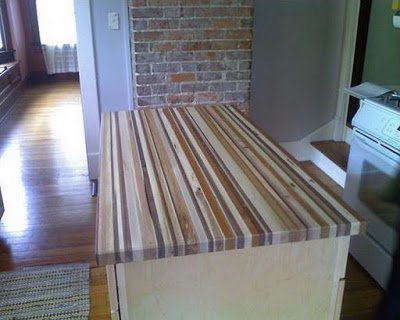
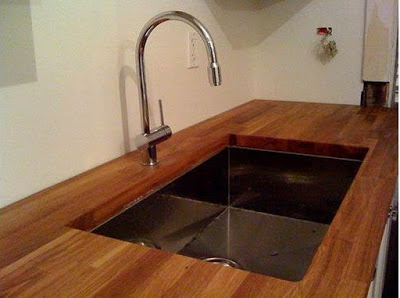
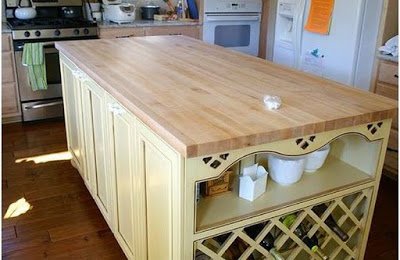

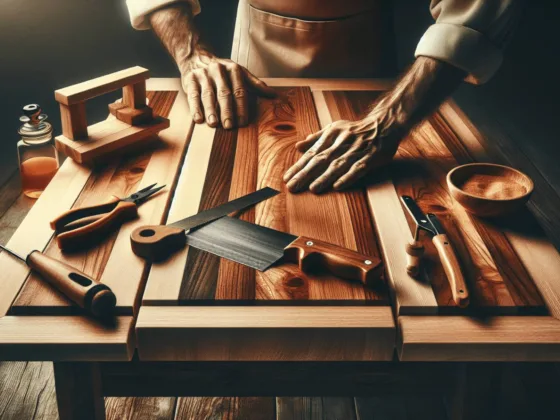




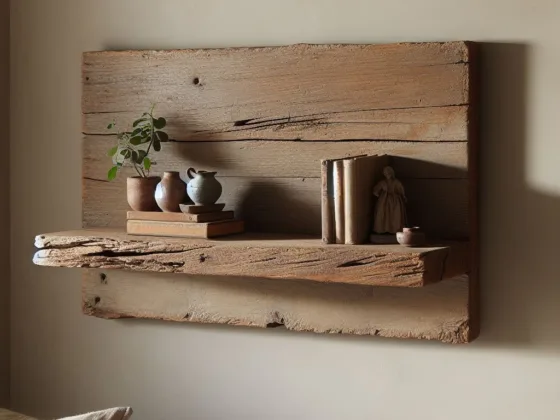
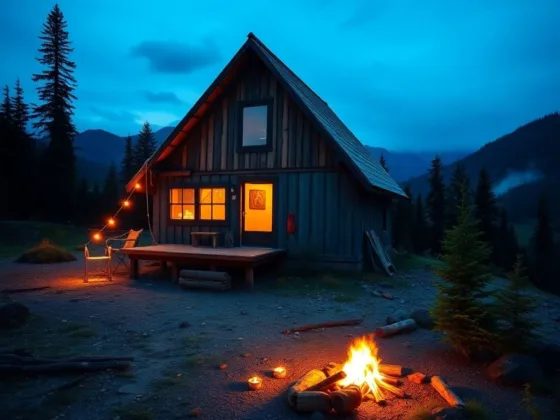
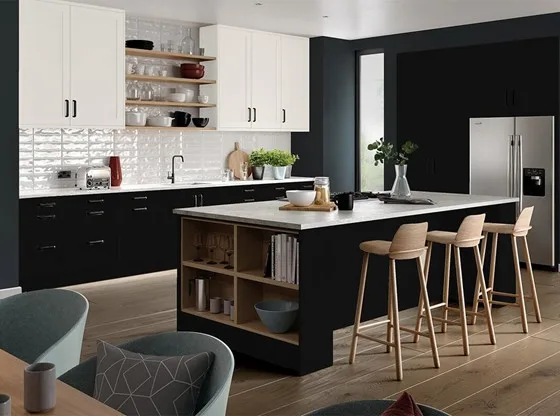
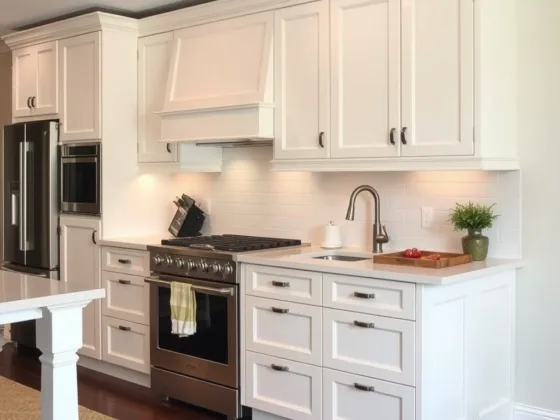
3 comments
As a little aside, I found that the piece removed for the sink cutout makes a great chopping board when cut and finished accordingly. It’s a nice little freebie, and it looks great a standalone decoration when not in use.
If you are a beginner or have done some woodworking you will find these plans: http://www.bestquicktips.com/woodworking-projects easy-to-follow as the instructions are very clearly written. Even if you are a total newcomer to woodworking you will be able to master all the techniques that are needed and the woodworking skills very quickly.